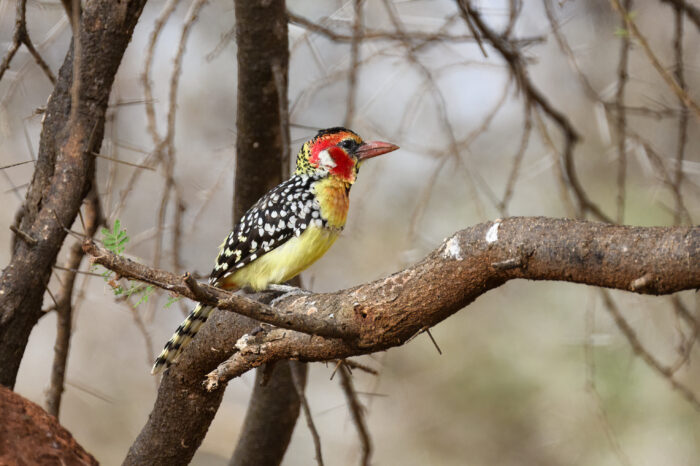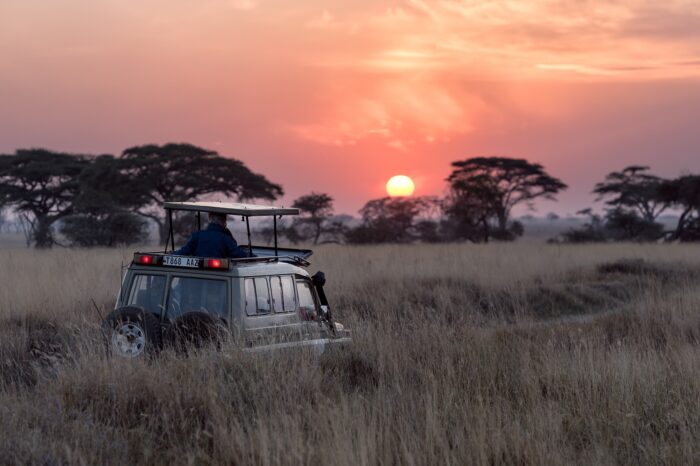Serengeti, Ngorongoro Crater & Northern Parks Birding Tour
Go birding in the best big game viewing parks in the world on this extraordinary 9-day Tanzania birdwatching tour.
Tanzania’s northern national parks stand unrivalled, and world-famous for exceptional reasons. From the vast expanses of the Serengeti savannah to the lush volcanic grasslands of the Ngorongoro Crater, this region is simply breathtaking. Abundant in big game and stunning birdlife, you are in for a treat – this tour is all about having fun!
*This tour can be organised as a private, tailor-made tour. Alternatively, please refer below for our scheduled group tour dates and associated costs.
Day 1: Arusha National Park
On our initial day, our rendezvous point will be at Kilimanjaro International Airport (or Arusha/Moshi) before we journey towards the breathtaking Arusha National Park, where our trip starts. This diverse park highlights a stunning array of landscapes, encompassing vast savannahs, lush rainforests, acacia woodlands, and ascending to alpine vegetation on Mount Meru’s higher slopes. Upon arrival, our safari vehicle will traverse the park while we indulge in birdwatching along the way. Exploring certain areas on foot for birding will undoubtedly be a highlight. With its rich blend of wildlife and avian species, Arusha National Park sets an exhilarating tone for our tour.
Where you will be staying: Rivertrees Country Inn
Day 2: Lark Plains
On our second day, we are set to explore Lark Plains, an area renowned for the elusive Tanzania endemic, Beesley’s Lark. These arid plains serve as a magnet for a diverse range of specialized avifauna adapted to dry environments, promising extensive on-foot birding opportunities. Although typically dry year-round, these plains witness substantial downpours from March to May, triggering rapid vegetation growth and attracting numerous passerines, raptors, and ground-dwelling species. Amidst our search for the Tanzania endemic, we will also keep an eye out for near-endemic species like the Athi Short-toed Lark, Red-throated Tit, and Short-tailed Lark, among other notable bird species.
Where you will be staying: Rivertrees Country Inn
Days 3 & 4: Tarangire National Park
Our next destination is the stunning Tarangire National Park. Abundant in both impressive game and diverse avifauna, this leg promises an unforgettable experience. The park derives its name from the perennial Tarangire River, a vital lifeline for the surrounding wildlife, particularly during the dry season when vast herds of wildebeest, zebra, and other animals gather here. Renowned for its scenic beauty and rich avian diversity, with a recorded count of over 500 species, we are eager to compile an extensive bird checklist within a brief period.
Species highlights: Ashy Starling, Red-and-yellow Barbet, Red-bellied Parrot, Von der Decken’s Hornbill, White-headed Buffalo-weaver, Vulturine Guineafowl, Yellow-collared Lovebird, Bare-faced Go-away bird, Donaldson Smith’s Nightjar, Northern Pied Babbler, Northern White-crowned Shrike to name a few.
Where you will be staying: Tarangire Simba Lodge
Day 5: Endoro Cave Trail (Endoro Falls)
We will be exploring Endoro Falls situated on the southern edge of Ngorongoro Forest. A fantastic trail winds through the forest, leading to the caves and the stunning Endoro Waterfalls. These caves hold significance for forest elephants, as they seek salt within; evident from the substantial carvings on cave walls created by their tusks during their mineral excavations.
Our entire day will be dedicated to traversing this trail, indulging in birdwatching as we go. Noteworthy species along this route include the Golden-winged Sunbird, Tacazze Sunbird, Eastern Double-collared Sunbird, Purple-throated Cuckooshrike, Grey Cuckooshrike, Moustached Tinkerbird, African Broadbill, Sharpe’s Starling, Klaas’s Cuckoo, and the majestic Crowned Eagle, among others.
Where you will be staying: Country Lodge Karatu
Day 6 & 7: Ngorongoro Crater
Over the next couple of days, you will be immersed in one of Africa’s most remarkable locations, and that is no exaggeration. In 2013, the crater was rightfully recognized as one of the Seven Natural Wonders of Africa. It stands as the largest inactive, intact, and unfilled volcanic caldera globally, formed through a colossal volcanic explosion and collapse two to three million years ago. Plunging 610 meters (2,000 feet) deep, its floor spans an extensive 260 square kilometres (100 square miles). The volcanic ash aftermath fostered fertile grounds, nurturing lush grasslands that sustain numerous ungulates. Our exploration through this area will be unhurried, allowing us to fully absorb the magnificent sights and engage in extensive birdwatching along the way. Expect a spectacular array of avifauna, with an impressive species count. Among the anticipated species are the Hunter’s Cisticola, Pectoral-patch Cisticola, Lyne’s Cisticola, Black-fronted Bush-Shrike, Thick-billed Seedeater, White-headed Barbet, Schalow’s Turaco, Shelley’s Francolin, Grey Crowned Crane, Fan-tailed Widowbird, Yellow-throated Sandgrouse, Kori Bustard, Secretarybird, and Rosy-breasted Longclaw, to mention just a few.
Where you will be staying: Lake Masek Tented Lodge
Days 8 & 9: Serengeti
Our final stop introduces you to Africa’s most iconic national park – the Serengeti. Renowned for a reason, this expansive ecosystem stands as one of the world’s last untamed wilderness areas. Endless plains stretch as far as the eye can see, hosting vast congregations of mammals, making it an unparalleled spectacle. The park’s crowning glory is the legendary Wildebeest Migration, where over 1.5 million wildebeest traverse the plains, following the life-giving rainclouds that nourish the grasslands below. This breathtaking phenomenon alone is bound to capture your heart. However, the avian diversity in this park is equally extraordinary, with over 500 recorded species. Among them are the endemic Grey-breasted Spurfowl and numerous near-endemics like the Abyssinian Wheatear, Red-throated Tit, Rufous-tailed Weaver, and Grey-crested Helmetshrike. Our birding checklist will also include sought-after species such as the White-crested Helmetshrike, Meyer’s Parrot, Yellow-throated Longclaw, and Zitting, Croaking, Desert Cisticolas, White-headed and Black Sawwings, and Paradise, Pin-tailed and Straw-tailed Whydahs.
Spending two immersive days slowly traversing this vast wilderness, we will soak in every aspect of its unparalleled beauty and wildlife before heading back to Arusha.
Where you will be staying: Acacia Central Camp
Tour pace:
Easy/Medium – This tour was crafted not only to achieve an extensive bird count but also to enjoy the magnificence of Tanzania’s breathtaking northern parks. We have allotted ample time at each location, ensuring that you can fully immerse yourself in the awe-inspiring spectacle each spot has to offer.
Tour difficulty:
Easy/Medium – on-foot birding but nothing too demanding. Walking boots and a sun hat are advisable.
Deposit:
We’d we need a 25% deposit to secure your place on this tour.
Cost:
The above cost is based on a group of 6 people. Please get in touch if you’d like us to arrange a private tailor made tour.
Single supplement:
£1,166
Best time of year to visit:
All year round but July is especially a good month for the wildebeest migration.
Sustainability:
At Sustainable Birding, our goal is to ensure that every birding holiday we create contributes positively to bird conservation efforts and local communities. Our determination to promote sustainable travel led us to become founding members of Tourism Declares Climate Emergency. As part of this commitment, we have established the world’s pioneering carbon scoring and offsetting framework for tailor-made holidays. Feel free to request us to carbon score your individual trip!
Tour Leader:
Issac is an avid birder, sound recorder, bird photographer, and field guide with a rich background in ornithology. Over the years, he has actively engaged in various citizen science projects, lending his expertise to bird mapping, nest watch programs, waterbird counts, and bird exploration expeditions. His insights have not only shaped co-authored semi-scientific papers but have also established him as a respected authority in the field.
In addition to his roles as a dedicated bird enthusiast, Issac played a pivotal role in founding the Tanzania Birders Community and the Kilusu Bird Club. These organizations have successfully united bird lovers across Tanzania, creating a collaborative space for participation in large-scale mapping projects. Issac introduced the innovative use of the Ebird app within the community, enhancing data collection efficiency and fostering widespread data sharing among members.
Issac’s passion for avifauna extends to his expertise as a bird sound recordist. His comprehensive collection of over 2300 bird sounds, meticulously cataloged on www.xeno-canto.org, stands as a testament to his dedication and keen ear. Many of these recordings have been instrumental in the development of cutting-edge birding applications, captivating birding enthusiasts globally.
Contributing to www.orniverse.com, Issac expertly describes and guides individuals through the breathtaking birding sites of Kenya and Tanzania. With nine years of invaluable experience as a field guide, he has led numerous successful birding tours, showcasing the expansive natural landscapes and diverse avian species found across Kenya and Tanzania. Issac’s knowledge, passion, and eagerness to share his expertise have made him a sought-after guide for those embarking on immersive birding experiences.
In summary, Issac is a dedicated bird enthusiast, versatile bird sound recordist, knowledgeable field guide, and accomplished bird photographer. His unwavering love for avian life and commitment to furthering citizen science significantly contribute to the understanding and conservation of birds in East Africa and beyond.

Bird species highlights:
- Beesley’s Lark
- Athi Short-toed Lark
- Red-throated Tit
- Short-tailed Lark
- Ashy Starling
- Red-and-yellow Barbet
- Red-bellied Parrot
- Von der Decken’s Hornbill
- White-headed Buffalo-weaver
- Vulturine Guineafowl
- Yellow-collared Lovebird
- Bare-faced Go-away bird
- Donaldson Smith’s Nightjar
- Northern Pied Babbler
- Northern White-crowned Shrike
- Golden-winged Sunbird
- Tacazze Sunbird
- Eastern Double-collared Sunbird
- Purple-throated Cuckooshrike
- Grey Cuckooshrike
- Moustached Tinkerbird
- African Broadbill
- Sharpe’s Starling
- Klaas’s Cuckoo
- Crowned Eagle
- Hunter’s Cisticola
- Pectoral-patch Cisticola
- Lyne’s Cisticola
- Black-fronted Bush-Shrike
- Thick-billed Seedeater
- White-headed Barbet
- Schalow’s Turaco
- Shelley’s Francolin
- Grey Crowned Crane
- Fan-tailed Widowbird
- Yellow-throated Sandgrouse
- Kori Bustard
- Secretarybird
- Rosy-breasted Longclaw
- Grey-breasted Spurfowl
- Abyssinian Wheatear
- Rufous-tailed Weaver
- Grey-crested Helmetshrike
- White-crested Helmetshrike
- Meyer’s Parrot
- Yellow-throated Longclaw
- Zitting Cisticola
- Croaking Cisticola
- Desert Cisticola
- White-headed Sawwing
- Black Sawwing
- Paradise Whydah
- Pin-tailed Whydah
- Straw-tailed Whydah
-
DepartureArusha
-
Departure Time5th July 2024
-
Return Time13th July 2024
-
IncludedAirport transfers.Private safari 4WD Toyota Land Cruiser with a 'pop-up' roof!Accommodation as shown based on twin room. Single supplement available.Full-board basis (breakfast, lunch & dinner).All national park entrance fees.Professional English-speaking guide/driver.Mineral water in the vehicle.Wi-fi in the vehicle.Medical emergency evacuation cover.
-
Not IncludedInternational flights.Optional activities unless specified as included.Excess baggage charges.Soft drinks & alcoholic beverages.Visas.
Similar Tours

Best of Northeastern Tanzania & Usambara Mountains
This Tanzania birding tour has been meticulously designed to offer you an unparalleled experience in the breath-taking North-eastern region of Tanzania. This area boasts some of Tanzania’s most exceptional birding locations.

Tanzania Endemics Birding Tour
Embark on an extensive Tanzania birding tour in pursuit of the country’s extensive array of endemic species. Carefully crafted, this birdwatching trip is tailored to highlight the finest of Tanzania, with a special emphasis on its remarkable endemic birds.




